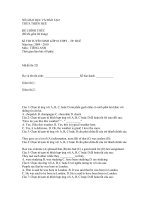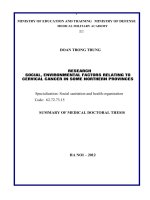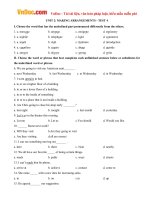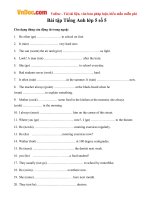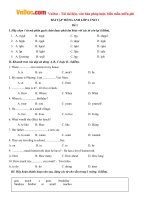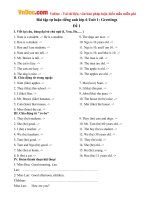- Trang chủ >>
- Sư phạm >>
- Sư phạm toán
Bài tập tiếng anh nghiên cứu hình sơ cấp
Bạn đang xem bản rút gọn của tài liệu. Xem và tải ngay bản đầy đủ của tài liệu tại đây (250.55 KB, 50 trang )
Bài tập tiếng anh: nghiên cứu hình sơ cấp.
Sinh viên thực hiện: Giáo viên hướng dẫn:
Trần Đình Tuấn (nhóm trưởng) Tiến sĩ:
Đào Thị Huyền Thương. Phạm Nguyễn Thu Trang
Nguyễn Huyền Trang.
Nguyễn Thị Hải Yến.
Nguyễn Ngọc Thúy.
Phạm Mai Trang.
Chapter I
Lines, Angles, and Triangles
Vocabulary:
Derive: nhận được từ,lấy được từ, suy ra.
Establish: thiết lập.
Survey: điều tra.
Navigation: đạo hàng, môn dẫn đường.
Astronomy: thiên văn học.
Occupations: sự chiếm, sự gữi.
Systematize: hệ thống hóa.
Undefined: không xác định.
Underlie: nằm ở dưới.
Description: sự diễn tả, mô tả.
Position: vị trí.
Chalk: phấn, đá phấn.
Civilization: nền văn minh.
Equidistant: cách đều.
Circumference: dường tròn, chu vi đường tròn.
Interchangeable: đổi lẫn được, hoán vị được.
Magnitude: độ lớn độ dài, chiều đo.
Altitude: chiều cao độ cao.
CONGRUENT: đồng dư.
2
1.1 HISTORICAL BACKGROUND OF GEOMETRY
The word geometry is derived from the Greek words geos (meaning earth) and metron
(meaning measure). The ancient Egyptians, Chinese, Babylonians, Romans, and Greeks
used geometry for surveying, navigation, astronomy, and other practical occupations.
The Greeks sought to systematize the geometric facts they knew by establishing logical
reasons for them and relationships among them. The work of such men as Thales F00 B.C.),
Pythagoras E40 b.c), Plato C90 b.c), and Aristotle C50 B.C.) in systematizing geometric
facts and principles culminated in the geometry text Elements, written about 325 B.C. by
Euclid. This most remarkable text has been in use for over 2000 years.
1.2 UNDEFINED TERMS OF GEOMETRY: POINT, LINE, AND PLANE
1.2.1 Point, Line, and Plane Are Undefined Terms
These undefined terms underlie the definitions of all geometric terms. They can be
given meanings by way of descriptions. However, these descriptions, which follow, are not
to be thought of as definitions.
1.2.2 Point
A point has position only. It has no length, width, or thickness.
A point is represented by a dot. Keep in mind, however, that the dot represents a point
but is not a point, just as a dot on a map may represent a locality but is not the locality. A
dot, unlike a point, has size.
3
1.2.3 Line
A line has length but has no width or thickness.
A line may be represented by the path of a piece of chalk on the blackboard or by a
stretched rubber band.
Two lines intersect in a point
A straight line is unlimited in extent. It may be extended in either direction
indefinitely.
A ray is part of a line. It has one end point and extends to infinity in one direction. A
ray is named starting with its end point first and then any other point on the ray second.
1.2.4 Planes
A plane has length and width but no thickness. It may be represented by a blackboard
or a side of a box; remember, however, that these are representations of a plane but are not
planes.
In mathematics, a plane is any flat, two-dimensional surface. A plane is the two
dimensional analogue of a point (zero-dimensions), a line (one-dimension) and a space
(three-dimensions). Planes can arise as subspaces of some higher dimensional space, as with
the walls of a room, or they may enjoy an independent existence in their own right, as in the
setting of Euclidean geometry.
A plane surface (or plane) is a surface such that a straight line connecting any two of
its points lies entirely in it. A plane is a flat surface.
1.3 LINE SEGMENTS
In geometry, a line segment is a part of a line that is bounded by two end points, and
contains every point on the line between its end points.
4
Examples of line segments include the sides of a triangle or square. More generally,
when the end points are both vertices of a polygon, the line segment is either an edge (of that
polygon) if they are adjacent vertices, or otherwise a diagonal. When the end points both lie
on a curve such as a circle, a line segment is called a chord (of that curve).
1.4 CIRCLE
1.4.1 History
“The circle has been known since before the beginning of recorded history. It is the
basis for the wheel, which, with related inventions such as gears, makes much of modern
civilization possible. In mathematics, the study of the circle has helped inspire the
development of geometry and calculus.
Early science, particularly geometry and astrology and astronomy, was connected to the
divine for most medieval scholars, and many believed that there was something intrinsically
"divine" or "perfect" that could be found in circles”.
1.4.2 Definition
A circle is a simple shape of Euclidean geometry consisting of those points in a plane
which are equidistant from a given point called the centre (or center; cf. American and
British English spelling differences). The common distance of the points of a circle from its
centre is called its radius.
Circles are simple closed curves which divide the plane into two regions, an interior
and an exterior. In everyday use, the term "circle" may be used interchangeably to refer to
either the boundary of the figure (also known as the perimeter) or to the whole figure
including its interior. However, in strict technical usage, "circle" refers to the perimeter
5
while the interior of the circle is called a disk. The circumference of a circle is the
perimeter of the circle (especially when referring to its length).
A circle is a special ellipse in which the two foci are coincident. Circles are conic
sections attained when a right circular cone is intersected with a plane perpendicular to the
axis of the cone.
1.4.3 Diameter
The diameter of a circle is the length of a line segment whose endpoints lie on the
circle and which passes through the centre of the circle. This is the largest distance between
any two points on the circle. The diameter of a circle is twice its radius.
As well as referring to lengths, the terms "radius" and "diameter" can also refer to actual line
segments (respectively, a line segment from the centre of a circle to its perimeter, and a line
segment between two points on the perimeter passing through the centre). In this sense, the
midpoint of a diameter is the centre and so it is composed of two radii.
1.4.4 Chord
A chord of a circle is a line segment whose two endpoints lie on the circle. The
diameter, passing through the circle's centre, is the longest chord in a circle. A tangent to a
circle is a straight line that touches the circle at a single point. A secant is an extended chord:
a straight line cutting the circle at two points.
1.4.5 Arc
An arc of a circle is any connected part of the circle's circumference. A sector is a
region bounded by two radii and an arc lying between the radii, and a segment is a region
bounded by a chord and an arc lying between the chord's endpoints.
6
1.5 ANGLES
1.5.1 An Angle in Geometry
In geometry, an angle is the figure formed by two rays sharing a common endpoint,
called the vertex of the angle. The magnitude of the angle is the "amount of rotation" that
separates the two rays, and can be measured by considering the length of circular arc swept
out when one ray is rotated about the vertex to coincide with the other (see "Measuring
angles", below). Where there is no possibility of confusion, the term "angle" is used
interchangeably for both the geometric configuration itself and for its angular magnitude
(which is simply a numerical quantity).
1.5.2 A Right Angle
A right angle is an angle with measure equal to 90 degrees.
1.5.3 An Acute Angle
An acute angle is an angle with a measure between 0 and 90 degrees.
7
1.5.4 An Obtuse Angle
An obtuse angle is an angle with a measure between 90 and 180 degrees.
1.5.5 Complementary Angles
Two angles are complementary if the sum of their measures is equal to 90 degrees.
Example: angles a and b with measures a = 19
o
and b = 71
o
are complementary since a + b =
90
o
8
1.5.6 Supplementary Angles
Two angles are supplementary if the sum of their measures is equal to 180 degrees.
Example: angles a and b with measures a = 122.1
o
and b = 57.9
o
are supplementary since
a+b = 180
o
.
1.6 TRIANGLES
1.6.1 Definition
A triangle is one of the basic shapes of geometry: a polygon with three corners or
vertices and three sides or edges which are line segments. A triangle with vertices A, B, and
C is denoted ABC.
In Euclidean geometry any three non-collinear points determine a unique triangle and
a unique plane (i.e. a two-dimensional Euclidean space).
1.6.2 Classifying Triangles
Triangles are classified according to the equality of the lengths of their sides or
according to the kind of angles they have.
Triangles According to the Equality of the Lengths of their Sides.
9
1.6.2.1. Scalene triangle: A scalene triangle is a triangle having no congruent sides.
1.6.2.2. Isosceles triangle: An isosceles triangle is a triangle having at least two
congruent sides.
1.6.2.3. Equilateral triangle: An equilateral triangle is a triangle having three
congruent sides.
Scalen Triangle
*no sides are equal
*all angles are different
Isosceles Triangle
*two sides are equal
*angles opposite the equal sides are equal
Equilateral Triangle
*all sides are equal and all angles are equal
to 60
0
1.6.3 Triangles According to the Kind of Angles
1.6.3.1.Right triangle: A right triangle is a triangle having a right angle.
1.6.3.2. Obtuse triangle: An obtuse triangle is a triangle having an obtuse angle.
1.6.3.3. Acute triangle: An acute triangle is a triangle having three acute angles.
10
Right triangle
one of the three angles of the triangle is a
right-angle
Obtuse triangle
all angles are less than 90
0
(acute)
Acute triangle
all angles are less than 90
0
(acute)
1.6.4 Special Lines in a Triangle
1.6.4.1. Angle bisector of a triangle: An angle bisector of a triangle is a segment or ray
that bisects an angle and extends to the opposite side.
1.6.4.2. Median of a triangle: A median of a triangle is a segment from a vertex to the
midpoint of the opposite side.
1.6.4.3. Perpendicular bisector of a side: A perpendicular bisector of a side of a
triangle is a line that bisects and is perpendicular to a side.
1.6.4.4. Altitude to a side of a triangle: An altitude of a triangle is a segment from a
vertex perpendicular to the opposite side.
1.6.4.5. Altitudes of obtuse triangle: In an obtuse triangle, the altitude drawn to either
side of the obtuse angle falls outside the triangle.
1.7 PAIRS OF ANGLES
1.7.1. Kinds of Pairs of Angles
11
1.7.1.1. Adjacent angles: Adjacent angles are two angles which have the same vertex
and a common side between them.
1.7.1.2. Vertical angles: Vertical angles are two nonadjacent angles formed by two
intersecting lines.
1.7.1.3. Complementary angles: Complementary angles are two angles whose
measures total 90°.
1.7.1.4. Supplementary angles: Supplementary angles are two angles whose measures
total 180°.
1.7.2. Principles of Pairs of Angles
Principle 1: If an angle of c° is cut into two adjacent angles of a° and b°, then
a°+b°=c°.
Principle 2: Vertical angles are congruent.
Principle 3: If two complementary angles contain a
0
and b°, then a° + b° =90°.
Principle 5: // two supplementary angles contain a° and b°, then a° + b° = 180°.
Principle 6: Adjacent angles are supplementary if their exterior sides lie in the same
straight line.Principle 7: If supplementary angles are congruent, each of them is a right
angle. (Equal supplemen- tary angles are right angles.)
12
Chapter 2
Congruent Triangles
2.1 CONGRUENT TRIANGLES
Congruent figures are figures that have the same size and the same shape; they are the
exact duplicates of each other. Such figures can be made to coincide so that their
corresponding parts will fit together. Two circles having the same radius are congruent
circles.
Congruent triangles are triangles that have the same size and the same shape.
If two triangles are congruent, their corresponding sides and angles must be
congruent.
Note in the congruent triangles how corresponding equal parts may be located.
Corresponding sides lie opposite congruent angles, and corresponding angles lie opposite
congruent sides.
2.1.1. Basic Principles of Congruent Triangles
Principle 1: If two triangles are congruent, then their corresponding parts are
congruent. (Corre- sponding parts of congruent triangles are congruent.)
Principle 2: If two sides and the included angle of one triangle are congruent to the
corresponding parts of another, then the triangles are congruent.
Principle 3: If two angles and the included side of one triangle are congruent to the
corresponding parts of another, then the triangles are congruent.
Principle 4: If three sides of one triangle are congruent to three si^es of another, then
the triangles are congruent.
2.2. ISOSCELES AND EQUILATERAL TRIANGLES
2.2.1.A Principles of Isosceles and Equilateral Triangles
13
Principle 1: If two sides of a triangle are congruent, the angles opposite these sides are
congruent. (Base angles of an isosceles triangle are congruent.)
Principle 2: If two angles of a triangle are congruent, the sides opposite these angles
are congruent. “Principle 2 is the converse of Principle 1”.
Principle 3: An equilateral triangle is equiangular. “Principle 3 is a corollary of
Principle 1”.
Principle 4: An equiangular triangle is equilateral. “Principle 4 is the converse of
Principle 3 and a corollary of Principle 2”.
14
Chaper 3:
Parallel Lines,Distances, And Angle Sums
3.1:Parallel Lines:
3.1.1:vocabulary:
parallel lines: các đường thẳng song song
transversal:đường hoành
alternate: luân phiên
adjacent angles:các góc kề nhau
position: vị trí
3.1.2: Definitions:
+ Parallel lines are straight lines which lie in the same plane and do not intersect however
they are extened.
+ A transversal of two or more lines is a line that cuts across these lines.
+ The interior angles formed by two lines cut by a transversal are the angles between the two
lines,while the exterior angles are those outside the lines.
+ Corresponding angles of two lines cut by a transversal are angles on the same side of the
transversal and on the same side of the lines.
+Alternate interior angles of two lines cut by a transversal are nonadjacent angles between
the two lines and on opposite sides of the tranversal.
3.1.3: Principles Lines:
+ Through a given point not on a given lines, one and only one can be drawn parallel to a
given line.
+ Two lines are parllel if and only if a pair of corresponding angles are congruent.
+ Two lines are parllel if a pair of alternate interior angles are congruent.
+ Two lines are parllel if a pair of interior angles on the same side of a tranversal are
supplementary.
15
+ Lines are parallel if they are perpendicular to the same line.
+ Lines are parallel if they are parallel if they are to the same line.
3.1.4:Properties of Parallel Lines:
+ If two lines are parallel, each pair of corresponding angles are congruent.
+ If two lines are parallel,each pair of alternate interior angles are congruent.
+ If two lines are parallel, each pair of interior angles on tha same side of the transversal are
supplementary.
+ Two lines are parllel, a line perpendicular to one of them is perpendicular to the others
also.
+ If lines are parallel,a line parallel to one of them is parallel to the others also.
+ If the sides of two angles are respectively to each other, the angles are either congruent or
supplemenary.
3.2: Distances:
3.2.1:Vocaburary:
Concentric: đồng tâm
Equidistant: Cách đều
Perpendicular: trực giao
Bisector:được chia làm hai
Determine: xác định
Distance : khoảng cách
Segment: đoạn thẳng
3.2.2:Distances between two geometric figures:
The distance between two geometric two geometric figures is the straight line segment
which is the shortest segment between the figures.
+ The distance between two points,such as P and Q, is the line segment PQ between
them.
+ The distance between a point and a line is the line segment which perpendicular
from the point to the line.
16
+ The distance between two parallels is the segment which perpendiculars between
the two parallels.
+ The distance between a point and a circle is the seg ment o between the poit\nt and
the circle.
+ The distance between two concentric circles is the segment of the larger radius that
lies between the two circles.>
3.2.3:Distance Principles:
+ If a point is on the perpendicular bisector of a line segment, then it is equiddistant
from the ends of the line seg ment.
+ If a point is equidistant from the ends of a line segment, then it is on the
perpendicular bisector of the line segment.
+ If a point is on the bisector of an angle, then it is equidistant from the sides of the
angle.
+ If a point is eqidistant from the sides of an angle,then it is on the bisetor of the
angle.
+ Two oints each equidstant from the ends of a line segment determine the
perpendicular bisec tor of the line segment.
+ The perpendicula bisectors of the sides of a triangle meet in a point which is
equidistant from the vertices of the triangle.
+ The bisectors of the angles of a triangle mett in a point which is equidistant from the
sides of the triangle.
3.3: Sum of the measures of the angles of a triangle:
3.3.1: Vocabulary
Measure: số đo
Obtuse angle: góc tù
Complemenly:phụ nhau
Isoceles triangle:tam giác cân
Right triangle: tam giác vuông
17
Nonadjacent: không nằm kề nhau
Supplementary: bù nhau
3.3.2 Interior and exterior angle og a polygon:
3.3.3:Angle-measure-sum principles:
+ The sum of the measures of the angles of a triangle equals the measure of a straight
angle or 180
0
.
+ if two angles of one triangle are congruent respectively to two angles of another
triangle, the remaining angles are congruent.
+ The sum of the measure of the angles of a quadrilateral equals 360
0
.
+ The measure of each axterior angle of a triangle equals the sum of the measures of
its two nonadjacent interior angles.
+ The sum of the measures of the exterior angles of atriangle equals 360
0
.
+ The measure of each angle of an equilatertal equals 60
0
.
+ The actue angle of a right triangle are complementary.
+ The measure of each acute angle of an isoceles righ triangle equals 45
0
.
+ A triangle can have no more than one right angle.
+ A triangle can have no more than one obtuse angle.
+ Two angles are congruent or supplementary if there sides are respectively
perpendicular to each other.
+ If S is the sum of the measures of the interior angles of a polygon of n sides, then S
= (n -2)180
0
.
+ The sum of the measures of the extreior angles of any polygon equals 360
0
.
18
Chapter 4
Parallelagrams,Trapezoids,Medians, and
Midpoints
4.1:vocabuary
Trapezoids: hình thang
Parallelagrams: hình bình hành
Median: đường trung bình
Parallelgrams: các cạnh song song
Midpoint:trung diểm
A base:cạnh đáy
A leg: cạnh bên
4.2: Definion and properties:
4.2.1 Trapezoids:
- Trapezoid is a quadrilateral having two and only two perallel sides.
- The median of the trapezoud is the segment join the midpoints of its legs.
- An isoceles trapezoid is a trapezoid whose legs are congruent.
+ The base angle of an isosceles trapezoid are congruent.
+ If the base angles of a trapezoid are congruent, the trapezoid is iosceles.
4.2.2: Parallelograms:
- A parallelogram is a quadrilater whose opposite sides are parallel.
- If the opposite sides of a quadrilateral are parallel, then it is a parallelogram.
+ The opposite sides of a parallelogram are paraell.
+ A diagonal of a parallelogram divides it into two congruent triangles.
19
+ The opposite sides of a parallelogram are congruent.
+ The opposite angles of a parallelogram are congruent.
+ The consecutive angles of a parallelogram are supplementary.
+ The diagonals of a parallelogram bisect each other.
* A quadrilateral is a parallelogram if its opposite are parallel.
* A quadrilateral is a parallelogram lelogram if its opposite sides are congruent.
* A quadrilateral is a parallelogram if two sides are congruent and parallel.
* A quadrilateral is a parallelogram if its opposite angles are congruent.
* A quadrilateral is a parallelogram if its diagonals bisect each other.
4.2.3: Special parallelograms: rectangle, rhombus, square
- A rectangle is an equiangular parallelogram.
- A rhombus is an equilareral parallelogram.
- A square is an equilateral and equiangular parallelogram.
+ A rectangle, rhombus or square has all the properties of aparallelogram.
+ Each angle of a rectangle is a right angle.
+ The diagonals of a rectangle are congruent.
+ All sides of a rhombus are congruent.
+ The diagonals of a rhombus are perpendicular bisection of each other.
+ The diagonals of a rhombus bisectthe vexter angles.
+ The diagonals of a rhombus from form four congruent triangles.
+ A square has all the properties of both the rhombus and the rectangle.
* If a parallelogram has one right angle, then it is a rectangle.
* If a parallelogram has congruent diagonals, then it is a rectangle.
* If a parallelogram has adjacent sides, then it is a rhombus.
* If a parallelogram has a right angle and two congruent adjacent sides, then it is a
square.
20
4.2.4: Three or more parallels; medians and midpoints
+ If three or more parallels cut off congruent segments on one transversal, then they
cut off congruent segmants on any other transversal.
+ If a line is drawn from the midpoint of one side of a triangle and parallel to a second
side, them it passes through the midpoint of the third side.
+ I a line joins the midpoints of two sides of a triangle, then it is parallel to the third
side and its length is one-half the length of the third side.
+ The median of a trapezoid is parallel to its bases, and its length is equals ons-half
the lenth of the hypotenuse.
+ The median of a triangle meet in a point which it is two-thirds of the distanse from
any vertex to the midpoint of the oppsite side.
21
Chaper 5
Circles
5.1: Vocaburary
Circle: đường tròn
Circumference: chu vi dường tròn
Radius: bán kính
Central angle:góc ở tâm
Arc: cung
Minor arc:cung nhỏ
Major arc: cung lớn
Intercept: chặn
Chord: dây cung
Diameter: đường kính
Secant: pháp tuyến
Tangent: tiếp tuyến
Inscribed polygon: đa giác nội tiếp
Circumscribeb circle: đa giác ngoại tiếp
Concentric circles: đường tròn ngoại tiếp
Inscribeb circle: đường tròn nội tiếp
5.2: Definions:
- A circle is the set of all points in a plane that are at the same distance from a fixed
point called the center.
- The circumference of a circle is the distance around the circle.
- A radius of a circle is a line segment joining the center to a point on the circle.
- A central angle is an angle formed by two radii.
22
- An arc is a cintinuous part of a circle.
- A chord of a circle is a line segment joining two points of the circumference.
- A diameter of a circle is a chord through the center.
- An inscribeb polygon is a polygon all of whole sides are chords of a circle.
- A circumscribeb circle is a circle passing through each vertex of a polygon.
- Concentric circles are circles that have the same center.
5.3:Circle principles:
+ A diameter divides a circle into two equals parts.
+ If a chord divides a circle into two equal parts, then it is diameter.
+ A point is out side, on, or inside a circle according to whether its distance from the
center is great than, equal to, or smaller than the radius.
+ Diameters of the same or congruent circles are congruent.
+ In the same or congruent circles, congruent central angles have congruent arcs.
+ In the same or congruent circles, congruent arcs have congruent central angles.
+ In the same or congruent circles, congruent chords have congruent arcs.
+ In the same or congruent circles, congruent arcs have congruent chords.
+ A diameter perpendicular to a chord bisects the chord and its arcs.
+ A perpendicular bisector of a chord passses through the center of the circle.
5.3.1: Tangent
+A tangent is perpendicular to the radius drawn to the point of contact.
+ A line is tangent to a circle if it is perperdicular to a radius at its outer end.
+ Tangents to a circle from an outside point are congruent.
+ The segment from the center of a circle to an uotside bisects th angle between the
tangents the piont o the circle.
5.3.2:Angle-measurement principcles;
23
+ A central angle is measured by its intercepted arc.
+ An inscribeb angle is measured by one-half intercepted arc.
+ In the same or congruent ciercle,congruent inscribeb angles have congruent
intercepted arcs.
+ In the same or congruent circles,inscribeb angles having vongruent intercepted arcs
are congruent.
+ An angle inscribeb in a semicircle is a right angle.
+ Parallel lines intercept congruent arcs on a circle.
+ An angle formed by a tangent and a chord is measured by one-half its intercepted
arc.
+ An angle formed by two intersecting chords is measured by one-half the sum of the
intercepted arcs.
+ An angle formed by two secants intercecting outside a circle is measured by one-
half the difference of the intercepted arcs.
+ An angle forms by a tangent and a secant intersecting outside a circle is measured
by one-half the difference of the intercepted arcs.
+ An angle forms by two tangents interseccting outside a circle is measured by one-
half the difference of the intercepted arcs.
24
Chapter6
Similarity:tính đồng dạng
6.1.ratios:tỉ số
6.1.1.Def
Ratios are used to compare quantities of division: the ratio of two quantities is the first
devided by the second.
A continued ratio:the ratio of three or more quantities may be expressed as a
continued ratio.
6.1.2.vocabulary
Colon: dấu 2 chấm
Decimal:thập phân
Eliminating:loại bỏ
Selarged:phân biệt
Enlager:rộng rãi
Unit:đơn vị
Lowest terms: số hạng nhỏ nhất
Adjacent: kề nhau
Acute:nhọn( góc)
6.2.proportion: tỷ lệ
6.2.1.def
A proportion is an equality of two ratios
25

